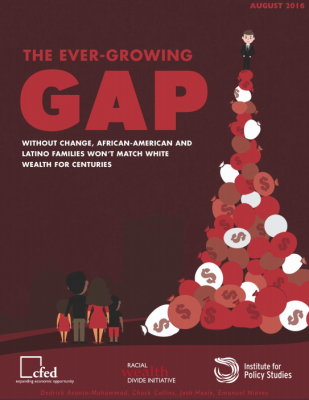http://www.epi.org/blog/a-tale-of-two-speeches/
This post originally appeared in Democracy.
This election will be different, not only because of the stark departure of Donald Trump's candidacy from any usual political convention, but also because the current economic debate is unlike any in recent memory. This was further elucidated by the plans each candidate laid out in Michigan this week. It is noteworthy, first of all, that both candidates have joined in calling for greater infrastructure spending, have abandoned the traditional approach toward trade and opposed the Trans-Pacific Partnership (TPP), have proposed subsidizing child care expenses, have highlighted wage stagnation, and have each claimed to be able to provide faster economic growth than the other.
It would be pointless, however, to delve into precise policy details without first commenting on the disturbing nature of the Trump candidacy. Among the least of his campaign's problems is that it fails to elaborate on any of its positions or provide any kind of science or data, that would allow a proper assessment of its proposals. Trump has offered many broad ideas about taxes, but the details are strikingly few. Similarly, Trump's budget plans just don't add up: He wants more military spending, more infrastructure spending, and no cuts to Medicare or Social Security, along with huge tax cuts—all while claiming he would still move toward a balanced budget. Of course, most problematic is Trump's bigotry and misogyny, and the egregious character flaws he displays almost daily: authoritarianism, dishonesty, volatility, and a lack of compassion.
But setting all that aside for the moment…
The inherent contradictions in Trump's rhetoric highlight the fact that the major, traditional divide between the parties is still present in this election. While the GOP candidate claims to offer more growth, he is, in reality, seemingly unconcerned about distributional questions (despite his claims to the contrary). Trump's growth agenda comes straight from the classic Republican or Chamber of Commerce playbook: tax cuts for corporations and the wealthy, along with deregulation of the economy, and a laissez-faire energy plan. Some populist. We know this will not actually generate better growth because it has failed to do so for the last four decades—otherwise, we would remember George W. Bush for the economic boom he created with his deep income, capital gains, and dividend tax cuts. We also know that growth, in and of itself, has not been associated with rising wages for most workers; these traditional GOP policies will, evidently, provide neither economic growth nor wage gains for the vast majority of workers.
Clinton, meanwhile, made it clear that she is actually both pro-growth and in favor of greater economic fairness. Clinton's plan is based, firstly, on job creation—through investments in infrastructure, help for small businesses, and "new market tax credits" to create jobs in high unemployment communities. In the past, she has also made it clear that she supports maintaining low interest rates and changing the composition of key Federal Reserve Board positions to ensure greater diversity, and make sure less bank industry insiders are represented—which would hopefully mean a stronger commitment to job growth. She has also promised to subsidize her proposed investments by making business and the wealthy pay their fair share of taxes. (Trump actually calls for even larger expenditures, claiming he will borrow to do so, which is actually a better approach than Clinton's. But it is difficult to take this stance seriously given that it is not embedded within any coherent budget plan.)
Clinton also promises a range of worker-friendly policies. She's called for stronger collective bargaining, higher minimum wages, equal pay for women, stronger overtime protections, and so on. And I've personally appreciated her emphasis on the essential role of strong unions for all workers. This is at the heart of Clinton's "fairness" agenda, and is critical for ensuring that growth actually yields results for the majority. Trump, on the other hand, is mostly silent on labor policy—though he's positioned himself on the opposite end of the spectrum with his endorsement of right-to-work laws, while he has taken every position imaginable on the minimum wage. His stance opposing any new form of regulation also contradicts all notions that he will foster fairness in his economic agenda.
Clinton took the opportunity on Thursday to challenge Trump, particularly on trade, pointing out that his bluster will not provide better policy results. Clinton highlighted a more vigorous trade enforcement plan, reiterated her opposition to the TPP ("I oppose it now, I'll oppose it after the election, and I'll oppose it as President"), and emphasized the need to address currency manipulation. It is refreshing that both candidates have departed so vigorously from the policies of corporate America and of Presidents Reagan, Bush, Clinton, W. Bush, and even Obama.
For example, on Monday, when Trump announced his support for a large income tax deduction for child care expenses, he was, at the very least, furthering the major debate regarding how to help working people balance both work and family. This will be the first time the major parties' candidates have focused on this issue. It should be noted that Trump's policy would not actually help the bottom forty-five percent who pay no income taxes and cannot benefit from more deductions—his plan is really geared toward the needs of high-income families. Clinton's plan, on the other hand, would limit child care costs to 10 percent of income and provide support to all families.
Restraining the incomes of the top 1 percent is essential for facilitating wage and income growth for all. Clinton's tax policies, along with her plans to further restrict Wall Street, would be an important step toward doing so. Trump would simply shovel more money to those at the top and further deregulate Wall Street. Despite his populist rhetoric, his policy proposals stand little chance of translating into any tangible gains for those Americans in need of a truly fairer economy.
-- via my feedly newsfeed


.jpg)
.jpg)
.jpg)
.jpg)

